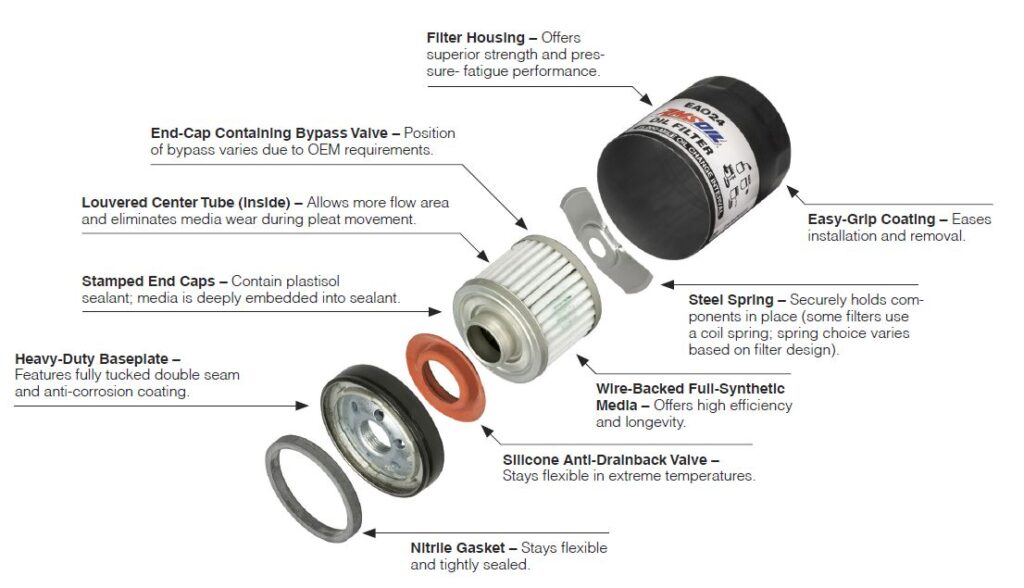Best Oil Filter – Synthetic Motor Oil

AMSOIL | Best Oil Filter Brand on The Market | Internal Components
- Filter Housing – Offers superior strength and pressure- fatigue performance
- End-Cap Containing Bypass Valve – Position of bypass varies due to OEM requirements.
- Louvered Center Tube (inside) – Allows more flow area and eliminates media wear during pleat movement.
- Stamped End Caps – Contain plastisol sealant; media is deeply embedded into sealant.
- Heavy-Duty Baseplate – Features fully tucked double seam and anti-corrosion coating.
- Easy-Grip Coating – Eases installation and removal.
- Steel Spring – Securely holds components in place (some filters use a coil spring; spring choice varies based on filter design).
- Wire-Backed Full-Synthetic Media – Offers high efficiency and longevity.
- Silicone Anti-Drainback Valve –Stays flexible in extreme temperatures.
- Nitrile Gasket – Stays flexible and tightly sealed.
Learn About The Best Oil Filter Brand
AMSOIL delivers Superior Oil Filtration for Cars, Light Trucks, Motorcycles and Powersports Equipment– AMSOIL Oil Filters feature advanced full-synthetic media that traps and holds a greater amount of small, wear-causing contaminants compared to conventional and other high-efficiency filters. They provide extended service intervals for increased convenience while helping reduce engine wear.
- Provides filtering efficiency of 99 percent at 20 microns*
- Allows lower restriction, keeping engine parts lubricated
- Provides greater capacity for small, wear-causing contaminants than competing filters
- Helps reduce engine wear
- Offers extended service life
* In accordance with industry-standard ISO SO 4548-12.
AMSOIL Ea Full-Flow Oil Filters
AMSOIL Ea Oil Filters’ (EAO) synthetic nanofibers have a controlled size and shape to provide greater efficiency, capacity, and durability than cellulose filters. AMSOIL Ea Oil Filters provide a higher level of engine protection and extended filter change intervals.
Ea Oil Filtration Media AMSOIL
Ea Oil Filter media is relatively thick and soft when compared to typical cellulose or cellulose / synthetic blend media. It is backed with wire mesh to provide structural integrity within the filter. The multi-layered characteristic of the media selectively filters the various contaminants, providing higher efficiency and longer filter life.
Superior Construction
AMSOIL Ea Oil Filters are equipped with an oil-pressure relief valve to provide adequate oil flow under all operating conditions. Each heavy-duty housing has a draw steel double-crimp at the base with rolled-under seaming. A silicone anti-drainback valve prevents dirty oil from moving back into the engine. Ea Oil Filters are designed to provide maximum filtration while meeting the high-flow demands of modern automobiles.
Absolute Efficiency
AMSOIL Ea Oil Filters have the best efficiency rating in the industry. Ea Oil Filters provide a filtering efficiency in accordance with industry standard testing (ISO 4548-12) of 98.7 percent at 15 µ, while competitive filters containing conventional cellulose media range from 40 to 80 percent.
Less Restriction
AMSOIL Ea Oil Filters provide significantly lower restriction than their cellulose counterparts. The exceptionally small spaces inherent to synthetic nanofiber technology trap more particles of microscopic size while also providing more space for oil flow. Synthetic nanofibers also provide less restriction during cold-temperature operation allowing oil to easily flow through the synthetic media, decreasing engine wear during warm-up periods.
More Capacity
A filter’s capacity refers to the amount of contaminants it can hold and still remain effective. AMSOIL Ea Oil Filters have a greater capacity for small, wear-causing contaminants than competing filters do. In most applications, when used in conjunction with AMSOIL synthetic motor oils in normal service, Ea Oil Filters are guaranteed to remain effective for up to 25,000 miles or one year, whichever first.
Funfact About Contaminant Size
Contaminants suspended in air or fluid can be very small. To grasp just how small these particles are, an understanding of the measurements involved in their classification is necessary.

The size of nanofibers is equal to one millionth of a meter – smaller than the diameter of a human hair.
